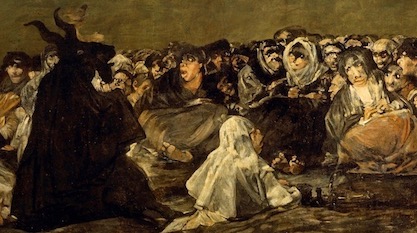 Neuroscience & Mind
Neuroscience & Mind
Explaining Abstract Thought in Materialist Terms: The Horns of a Dilemma


Neuroscientist Michael Egnor has been engaged in a debate with University of Toronto psychiatry professor Faizal Ali. Their topic is whether a material organ alone, the brain, or purely material processes, can explain the human gift for abstract thought. That is an endowment seemingly unique to humans. Materialists need to give an account of it in materialist terms, otherwise their picture of reality falls to pieces.
Dr. Ali started out critiquing Dr. Egnor’s views (expressed in the Science Uprising series) from a perch at the website Peaceful Science. He has since launched a blog of his own, Better Right Than Happy, with the subtitle, “Let’s try to be rational about this.” The blog is decorated with a reproduction of Francisco Goya’s extremely eerie Witches’ Sabbath (1821-1823). (See above.)
Nobody Expects the Spanish Inquisition
What an interesting choice of art. What’s up with that? Goya painted other works on the same theme. According to Wikipedia, “[I]n a Spanish context, Goya’s paintings have been seen as a protest against those who upheld and enforced the values of the Spanish Inquisition.” You mean like a certain soft-spoken pediatric neurosurgeon we know? They “can be seen as an attack on the superstitious beliefs rife in Spain during a period when tales of midnight gatherings of witches and the appearance of the devil were commonplace among the rural populace. They reflect the artist’s disdain for the popular tendency towards superstition.”
Oh, so that’s it? I assume the picture was a deliberate choice, with a polemical edge. Dr. Ali launched the blog, it seems, as a place to criticize Dr. Egnor and other skeptics on Darwinian evolution and materialist origins theories in general. Our skepticism is implicitly depicted as antiquated, persecutory superstition. Tom Wolfe got it much closer to right when he said, in an interview with The New Yorker, that today’s real Inquisition is arrayed against proponents of intelligent design (who include Michael Egnor).
Or perhaps the painting means something different to Dr. Ali. Anyway, as he wrote in the initial post on his blog:
My extra-professional interests include discussion and debate regarding the denial of certain scientific facts and theories, a denial that is often motivated by religious beliefs. The theory of evolution is probably the most commonly denied theory…
This is all a bit of background to recommending that you read Egnor’s two most recent posts at Mind Matters, in which he continues his dispute with Faizal Ali.
A Departure from Reason?
Tell me, is there any departure by Egnor from Ali’s motto, “Let’s try to be rational about this”? Not that I can see. In fact in his most recent post, Egnor has cornered Ali just by being “rational about this.” He concludes:
The standard materialist theory of abstract thought is that it arises from the intricacy and complexity of neural networks in the cerebral cortex. That is Dr. Ali’s argument. But this materialist argument is really just hand-waving amounting to magic (“lots of neurons fire together… and suddenly abstract thought appears!”)
Materialists never explain how the firing of lots of neurons (magically) evokes abstract thought. You just have to trust them on that.
Materialists use this claim of “delicate complexity” theory to attempt to explain why seizures and brain stimulation never evoke abstract thought. The brain mechanisms for abstract thought are said to be too delicate and complex!
But this argument leaves the materialist theory vulnerable to equally compelling ablation research. That is, if abstract thought depends critically on delicate complexity of neural networks, then certainly such networks would be disrupted or destroyed by split-brain surgery or by the massive diffuse brain damage that causes persistent vegetative state.
Yet, contrary to materialist theory, patients after split-brain surgery have completely normal abstract thought (the only changes are subtle changes in non-abstract perceptual thought). Also, patients in a persistent vegetative state often retain high levels of abstract thought despite massive diffuse destruction of much of their brain.
Materialists can’t have it both ways. Either abstract thought depends on delicate complex brain interconnections, or it doesn’t. Not both.
The truth is that the neuroscience research applicable to the question of the materiality or immateriality of abstract thought only makes sense if we acknowledge that abstract thought is not a product of the brain at all. To wit, neuroscience research has shown no correlation between abstract thought and brain activity (Libet’s ‘free won’t’), neuroscience research has shown no evocation of abstract thought by stimulation of the brain or by seizures (Penfield), and neuroscience research has shown no ablation of abstract thought by splitting the brain in half (Sperry) or by massive diffuse brain damage (Owen).
Materialists may attempt to explain one of these findings (with the usual hand-waving), but they cannot explain all of them because materialism would have to contradict itself to explain all these results. If abstract thought is caused by delicate complex brain interconnections, then it should be easily destroyed by cutting those interconnections.
It’s time that materialists set aside their metaphysical bias and follow the obvious scientific evidence. The only explanation that accounts for all of the evidence in neuroscience — correlative, evocative and ablative — is that abstract thought is an immaterial power of the mind.
It’s the dualist here, Michael Egnor, who is urging the materialist to reject superstitious bias, to give up “hand-waving amounting to magic,” to “follow the obvious scientific evidence.” Faizal Ali isn’t the first to tar those who earnestly follow the evidence as being under the influence of benighted delusion. Yet it is Egnor who has pinned Ali down, not on the devil’s horns, but on the horns of an inescapable logical dilemma. Read the rest at Mind Matters.
Image: Witches’ Sabbath, by Francisco Goya, via Wikimedia Commons (cropped).
